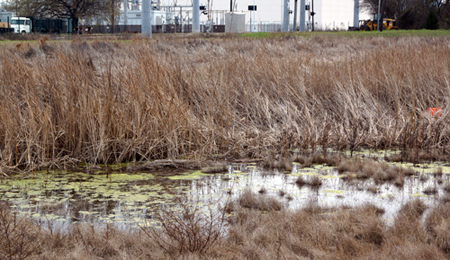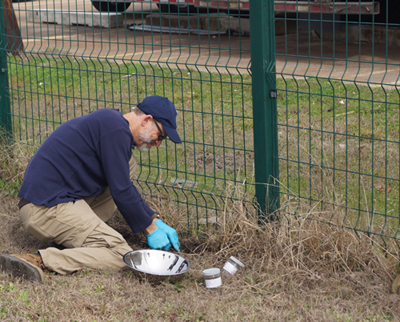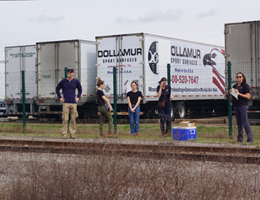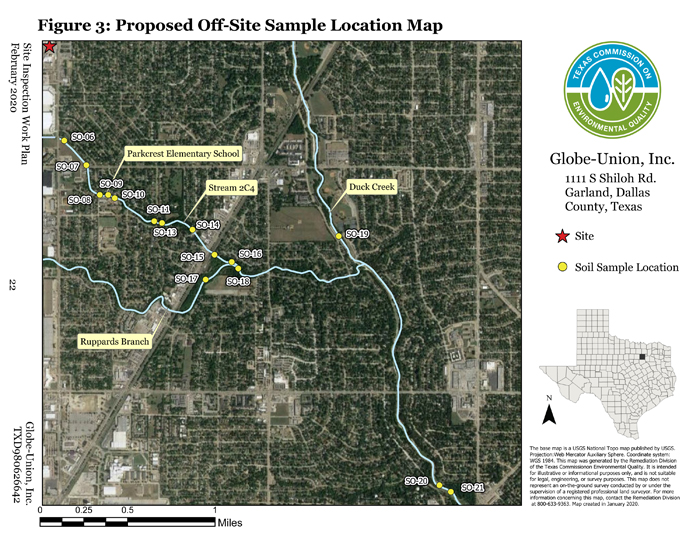After a long wait by neighborhood residents, and at the request of the Environmental Protection Agency (EPA), the Texas Commission on Environmental Quality (TCEQ) recently took soil samples from the former Globe Union, Inc. site at 1111 South Shiloh Road. Samples were also taken from nearby commercial and industrial property and runoff paths along the nearby creek.
Globe Union, Inc. was a manufacturer of lead oxide batteries from the 1950s through 1995. These 21 samples will be tested for lead and other contaminants. Samples were taken at a depth of six inches.
Questions about possible contamination in this area have come up for many years as there are numerous manufacturing and industrial sites that use dangerous chemicals in their processes. More than 20 years ago, two residents, Rhonda Mullen and Holli Sanborn, began to wonder about what they thought to be an unusually high number of occurrences of cancer deaths and other serious health conditions in the Meadowlark Estates neighborhood (east side of Shiloh Road between Forest Lane and Miller Road). At that time, Mullen and Sanborn went door to door and found a number of health problems and deaths which led them to believe something was wrong. At that time, they communicated with the city of Garland, along with state and federal agencies but felt that they were not taken seriously.

A couple of years ago, with the help of these same residents and others who had also noticed serious health issues, brought the subject to light again. Don Phillips, who grew up in Meadowlark Estates, picked up the investigation and has been joined by numerous current and past residents of Meadowlark Estates as well as Williams Estates (adjacent to Meadowlark Estates) and English Estates (south of Miller Road and east of Shiloh Road).
Phillips and others have spent countless hours researching, compiling information and talking with representatives from the city of Garland, the TECQ and the EPA.
In 2019, the group ordered soil testing from TTI Environmental Laboratories based in Arlington. Those samples indicated higher than normal levels of some of the metals for which the soil was being tested. These test results prompted the EPA to order  further soil testing.
further soil testing.
The EPA’s soil samples have been taken and the residents will have an answer in approximately 90 days.
According to EPA documents, sample locations were chosen based on possible drainage/runoff into nearby creeks and streams. Locations are noted on the map below.
Bret Kendrick, an environmental scientist with the EPA said that there were a couple of drums in a nearby creek and samples will be taken by those.
“Then we are just going to follow the surface water pathway down into the neighborhood,” he said.
Phillips said that residents have a right to know if they are living in an unhealthy environment. He also said that, according to records he has found, there are other potentially dangerous sites in Garland that should be checked.
The following information describing the health effects of lead is from the EPA’s
website. https://www.epa.gov/lead/learn-about-lead#effects
What are the Health Effects of Lead?
Lead can affect almost every organ and system in your body. Children six years old and younger are most susceptible to the effects of lead.
Children – Even low levels of lead in the blood of children can result in:
- Behavior and learning problems
- Lower IQ and Hyperactivity
- Slowed growth
- Hearing Problems
- Anemia
In rare cases, the ingestion of lead can cause seizures, coma and even death.
Pregnant Women – Lead can accumulate in our bodies over time, where it is stored in bones along with calcium. During pregnancy, lead is released from the mother’s bones along with calcium and can pass from the mother exposing the fetus or the breastfeeding infant to lead. This can result in serious effects to the developing fetus and infant, including:
- Cause the baby to be born too early or too small;
- Hurt the baby’s brain, kidney’s, and nervous system;
- Increase the likelihood of learning or behavioral problems; and
- Put the mother at risk for miscarriage.
Other Adults – Lead is also harmful to other adults. Adults exposed to lead can suffer from:
- Cardiovascular effects, increased blood pressure and incidence of hypertension
- Decreased kidney function
- Reproductive problems (in both men and women)
Where is Lead Found?
Lead can be found in all parts of our environment – the air, the soil, the water, and even inside our homes. Much of our exposure comes from human activities including the use of fossil fuels including past use of leaded gasoline, some types of industrial facilities, and past use of lead-based paint in homes. Lead and lead compounds have been used in a wide variety of products found in and around our homes, including paint, ceramics, pipes and plumbing materials, solders, gasoline, batteries, ammunition, and cosmetics.
Lead may enter the environment from these past and current uses. Lead can also be emitted into the environment from industrial sources and contaminated sites, such as former lead smelters. While natural levels of lead in soil range between 50 and 400 parts per million, mining, smelting, and refining activities have resulted in substantial increases in lead levels in the environment, especially near mining and smelting sites.
When lead is released to the air from industrial sources or spark-ignition engine aircraft, it may travel long distances before settling to the ground, where it usually sticks to soil particles. Lead may move from soil into groundwater depending on the type of lead compound and the characteristics of the soil.



